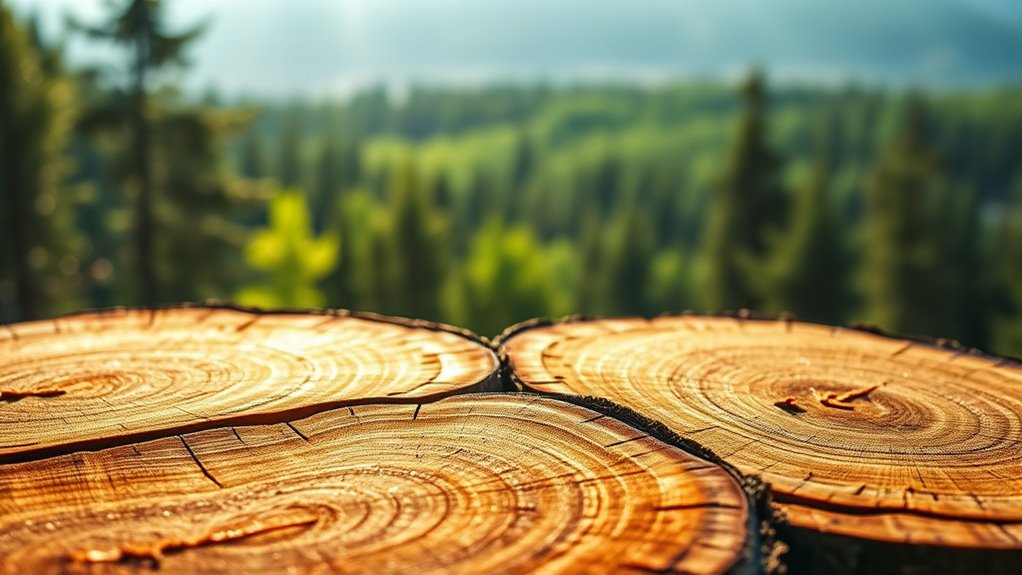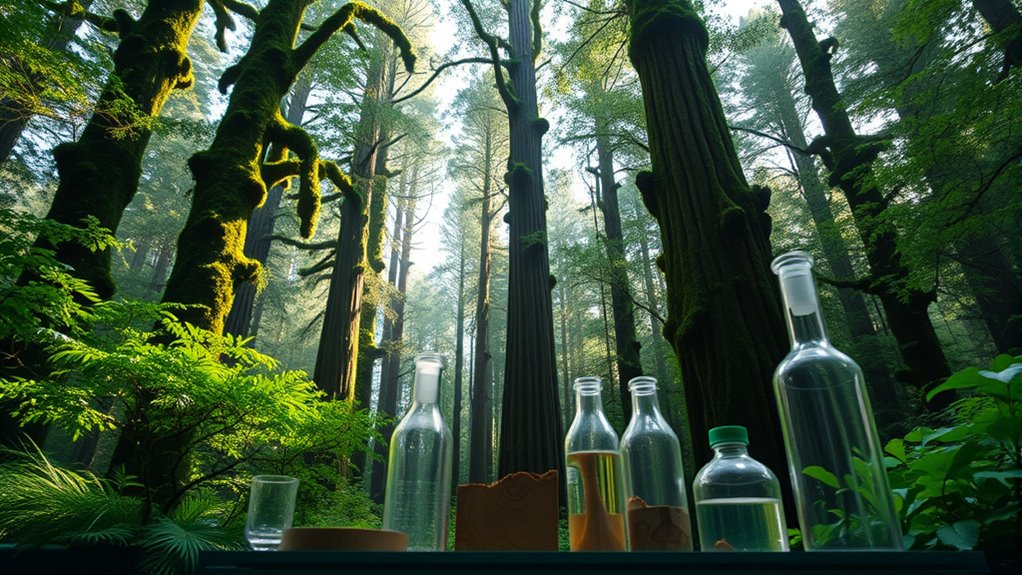Lab-grown wood can truly help save forests by offering a sustainable, biodegradable alternative that reduces the need to harvest mature trees. It eases pressure on natural habitats, fights illegal logging, and supports environmental conservation efforts. This innovative material can be used in construction, packaging, and urban spaces, lessening our environmental footprint. If you want to discover how this technology is transforming conservation and sustainability, explore more about its potential impact.
Key Takeaways
- Lab-grown wood reduces the need for harvesting mature trees, easing pressure on natural forests.
- It offers a sustainable, environmentally friendly alternative for industries like construction and furniture.
- Using lab-grown wood helps combat illegal logging and deforestation worldwide.
- It supports ecological conservation by preserving biodiversity and protecting natural habitats.
- The technology enables urban green spaces and eco-friendly packaging, contributing to overall forest preservation efforts.

As concerns about deforestation and environmental degradation grow, lab-grown wood emerges as a promising solution to preserve natural forests. Instead of harvesting trees from delicate ecosystems, you can now access sustainable wood alternatives produced in laboratories that mimic natural growth processes. This innovation has the potential to markedly reduce the pressure on forests, helping to combat illegal logging and deforestation.
With less reliance on cutting down mature trees, you contribute to maintaining biodiversity and protecting essential habitats for countless species. Lab-grown wood can serve as a versatile material for various industries, including construction, furniture, and packaging, all while alleviating the environmental toll of traditional logging practices.
One compelling advantage of lab-grown wood is its potential to revolutionize packaging, particularly through biodegradable packaging options. As you become more environmentally conscious, you might seek out products wrapped in biodegradable packaging that decomposes naturally, reducing landfill waste.
Lab-grown wood-based materials can be engineered to break down quickly and safely, offering an eco-friendly alternative to plastics and non-biodegradable packaging. This shift not only lessens pollution but also aligns with global efforts to create a circular economy where waste is minimized and resources are reused.
By choosing products made from lab-grown wood, you support industries that prioritize sustainability and innovation, helping to decrease the environmental footprint associated with packaging waste.
Furthermore, lab-grown wood offers a promising way to enhance urban green spaces. Cities worldwide are increasingly investing in green infrastructure to improve air quality, reduce heat islands, and promote mental well-being.
You can envision using lab-grown wood in the construction of parks, community gardens, or even urban furniture—benches, planters, or playground equipment—that blend seamlessly into green environments. Because lab-grown wood can be produced with minimal environmental impact, it becomes an ideal material for sustainable urban development.
Its use can help create more accessible, eco-friendly spaces where residents connect with nature, fostering community resilience and ecological awareness. As cities expand and face growing environmental challenges, lab-grown wood presents an innovative way to support urban greening initiatives without further straining natural forests.
In essence, lab-grown wood holds the potential to transform multiple facets of environmental conservation. From reducing the need for destructive logging to providing biodegradable packaging solutions and enriching urban green spaces, this technology allows you to participate actively in protecting the planet. Incorporating high-quality content It’s a promising step toward a future where ecological balance is maintained, and natural forests can thrive for generations to come.
Frequently Asked Questions
How Does Lab-Grown Wood Compare in Cost to Natural Wood?
You might wonder about the cost comparison between lab-grown and natural wood. Generally, lab-grown wood has a higher initial production cost due to advanced technology and infrastructure.
However, as the process becomes more efficient and scaled up, its economic viability improves, potentially lowering prices. Over time, lab-grown wood could become competitive with natural wood, offering a sustainable alternative that benefits both the environment and your budget.
What Environmental Impacts Are Associated With Producing Lab-Grown Wood?
You’ll find that producing lab-grown wood offers positive environmental impacts by supporting sustainable sourcing and reducing deforestation. It minimizes habitat destruction, helping preserve biodiversity and natural ecosystems.
Additionally, lab-grown wood typically requires less water and energy compared to traditional forestry, lowering pollution and carbon emissions.
Can Lab-Grown Wood Be Used for All Types of Wooden Products?
Like a chameleon adapting to its surroundings, lab-grown wood offers remarkable versatility. You can use it for many wooden products, thanks to its synthetic durability and aesthetic versatility.
While it’s suitable for furniture, flooring, and decorative pieces, some complex or traditional items might still benefit from natural wood’s unique qualities.
How Scalable Is Lab-Grown Wood Production Globally?
You might wonder about the scalability of lab-grown wood production globally. While promising, it faces scalability challenges like high costs and technical limits in large-scale manufacturing.
Currently, global production isn’t widespread, but ongoing innovations aim to increase efficiency and reduce expenses.
If these hurdles are overcome, lab-grown wood could be produced at scale, helping to meet demand sustainably and lessen pressure on natural forests worldwide.
Will Lab-Grown Wood Affect Traditional Forestry Jobs?
Imagine a future where progress and tradition dance together. Lab-grown wood might reshape traditional forestry jobs, but it could also open new opportunities amid urban development.
You’ll find that this innovation helps preserve cultural heritage by reducing deforestation. While some roles may change, the focus shifts to sustainable practices, ensuring that both economic growth and environmental preservation thrive hand-in-hand.
Embrace this evolution as a chance to protect nature’s legacy.
Conclusion
Imagine holding a delicate, real-looking leaf that’s actually made in a lab to save the forest. Lab-grown wood is like that—an innovative solution that can reduce deforestation and protect natural habitats. Scientists say it’s a game-changer, much like finding a new tool to help an overworked craftsman. With ongoing research, you can see a future where forests thrive alongside human progress, proving that technology can be a powerful ally in preserving our planet’s beauty.










